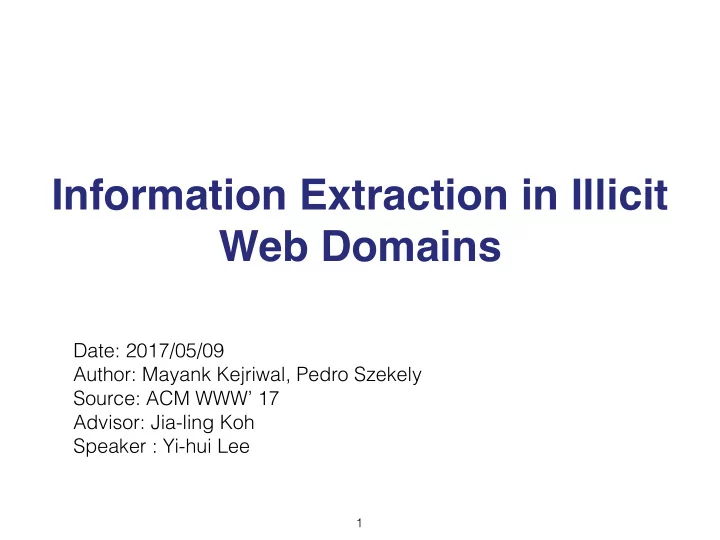

Information Extraction in Illicit Web Domains Date: 2017/05/09 Author: Mayank Kejriwal, Pedro Szekely Source: ACM WWW’ 17 Advisor: Jia-ling Koh Speaker : Yi-hui Lee 1
Outline • Introduction • Approach • Experiment • Conclusion 2
Introduction • Information Extraction: 3
Introduction(cont.) • Information Extraction on Dark web(human trafficking): ages (of human trafficking victims) locations prices of services posting dates 4
Introduction(cont.) • A high-level overview of the proposed information extraction approach: input: Dark Web step 1 step 3 step 4 word representation learning preprocessing supervised classifier Apply recognizers step 2 output:Annotated corpus 5
Outline • Introduction • Approach • Experiment • Conclusion 6
Approach • Step 1. Preprocessing: Readability Text Extractor(RTE): -> Mercury Web Parser NLTK: -RTE string output -> sentence tokenize -> word tokenize -> list of tokens 7
Approach(cont.) • Step 2. Apply recognizers: GeoNames-Cities GeoNames-States RegEx-Ages: use regular expressions Dictionary-Names: person names 8
Approach(cont.) • Step 3. Word Representation learning: D1: The cow is in the farm. D2: I jumped over the farm. D3: I saw a cow in the farm. D1 D2 D3 The 1 0 0 cow 1 0 1 jumped 0 1 0 over 0 1 0 the 1 1 1 moon 0 0 0 farm 1 1 1 sim(cow, farm) = 2/(sqrt(2)+sqrt(3)) = 0.64 sim(cow, moon) = 0 9
Approach(cont.) • Step 3. Word Representation learning: Random Index [27] - randomly assigned -1, 0, 1 to the vector’s attribute 10
Approach(cont.) • Step 4. Supervised Contextual Classifier: Aggregate vectors -> l2-normalization I saw a cow jumped over the farm saw = [1, 0, 0, …, 1, 0] a = [1, 1, 1, …, 1, 1] cow = [1, 0, 1, …, 0, 0] jumped = [0, 0, 0, …, 1, 1] over = [0, 0, 1, …, 0, 1] aggregate = [1, 0, 0, …, 1, 0, 1, 1, 1, …, 1, 1, ……, 0, 1] l2-normalization = [0.0001, 0, 0, …, 0.0001, 0, 0.0001, 0.0001, 0.0001, …, 0.0001, 0.0001, ……, 0.0000, 1] 11
Approach(cont.) • Step 4. Supervised Contextual Classifier: Classifier: Random forest 12
Outline • Introduction • Approach • Experiment • Conclusion 13
Experiment • Datasets and Ground-truths: Research conducted in the DARPA MEMEX program • Ground-truths: 14
Experiment(cont.) • Baselines: Stanford Named Entity Recognition system (NER) 15
Experiment(cont.) • Evaluation: 16
Experiment(cont.) • Feature selection: 17
Outline • Introduction • Approach • Experiment • Conclusion 18
Conclusion • We presented a lightweight, feature-agnostic Information Extraction approach that is suitable for illicit Web domains. • Our approach relies on unsupervised derivation of word representations from an initial corpus, and the training of a supervised contextual classifier using external high-recall recognizers and a handful of manually verified annotations. • Real-world settings: End Human Trafficking hackathon organized by the office of the District Attorney of New York17 19
Recommend
More recommend